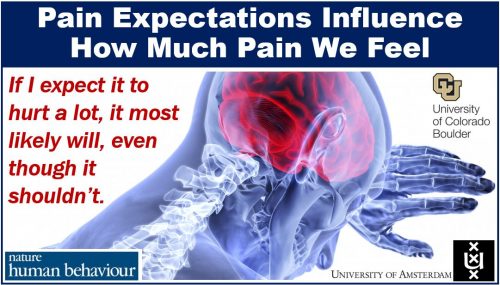Our pain expectations can determine how much pain we feel, a new study has shown. In other words, the more painful we expect something to be, the more painful it is than it should be. If we expect an injection to hurt, it probably will, even if the needle poke isn’t that painful.
According to Mike, the founder of Supernatural Botanicals (kratom products for pain) store:
“Pain is an unpleasant and distressing sensation that can limit our capabilities and abilities to carry out simple tasks. It is often, but not always, a symptom of an underlying condition.”
As people brace for a second injection, they will probably flinch again, even though – by then – they should know better.
This is what a team of neuroscientists from Colorado University Boulder and the University of Amsterdam found after carrying out a new brain imaging study. Our expectations of pain intensity can become self-fulfilling prophecies, they say. These false pain expectations can persist even when experience demonstrates otherwise.
Tor Wager and colleagues wrote about their study and findings in the prestigious journal Nature Human Behavior (citation below).
Wager is a Professor at UC Boulders Institute of Cognitive Science.
Senior author, Prof. Wager, said:
“We discovered that there is a positive feedback loop between expectation and pain. The more pain you expect, the stronger your brain responds to the pain. The stronger your brain responds to the pain, the more you expect.”

Pain expectations – a self-fulfilling prophecy
For many years, scientists have been fascinated by the notion of self-fulfilling prophecies. Studies have shown that expectations can influence everything from how effective a medication is to how well we do in a test.
This study is the first to determine whether pain expectations affect how much pain we feel. It is also the first study to elucidate the neural mechanisms behind the phenomenon.
Marieke Jepma, who was a postdoctoral researcher in Wager’s lab, launched the research. She launched it after noticing that test subjects still had pain expectations when they were shown repeatedly that something would not hurt so badly.
Lead author, Dr. Jepma, who is now a researcher at the University of Amsterdam, said:
“We wanted to get a better understanding of why pain expectations are so resistant to change.”
Pain expectations – the study
The research team recruited 34 participants. They taught them to associate one symbol with high, painful heat and another with low heat.
The researchers placed the participants in an fMRI machine. fMRI stands for functional magnetic resonance imaging. fMRI machines measure brain activity by detecting changes in associated blood flow.
For one hour, the researchers showed participants low or high pain cues, and then asked them to rate how much pain they expected.
The participants received varying degrees of painful heat to their forearm or leg. Although the heat was painful, it was not damaging. The most painful level, Prof. Wager explained, was “about what it feels like to hold a hot cup of coffee.”
They then had to rate their pain. The participants did not know that heat intensity was not related to the preceding cue. In other words, if they saw a high pain cue, that did not mean they would subsequently receive a high level of heat.
fMRI showed how pain expectations affected pain
The fMRI scans showed that when participants expected more heat, brain regions involved in fear and threat were more activated as they waited. Also, when they received the heat, regions in the generation of pain were more active.
The subjects reported more pain after seeing high-pain cues, regardless of the degree of heat they received.
Dr. Jepma said:
“This suggests that expectations had a rather deep effect, influencing how the brain processes pain.”
‘Confirmation bias’ also applies to pain
The researchers were surprised that the participants’ pain expectations also highly influenced their ability to learn from experience. Many participants demonstrated strong ‘confirmation bias.’
Confirmation bias is our tendency to learn from things that confirm and reinforce what we believe and discount those that don’t. For example, if I expected high pain and then got it, I might expect the experience to be even more painful next time.
In the case of the participants, if they had high pain expectations and didn’t get it, nothing changed.
Prof. Wager said:
“You would assume that if you expected high pain and got very little, you would know better the next time. But interestingly, they failed to learn.”
Can pain expectations affect recovery?
Dr. Jepma suggests that this phenomenon might have tangible impacts on recovery from painful conditions.
Dr. Jepma said:
“Our results suggest that negative expectations about pain or treatment outcomes may in some situations interfere with optimal recovery, both by enhancing perceived pain and by preventing people from noticing that they are getting better. Positive expectations, on the other hand, could have the opposite effects.”
The researchers hope that their findings may shed light on why some chronic pain patients continue feeling pain after damaged tissues have healed.
The researchers suggest that it may do us good to be aware of our eagerness to confirm our pain expectations. From a mental health point of view, we should also be aware of our inherent eagerness to confirm other types of expectations.
Dr. Jepma said:
“Just realizing that things may not be as bad as you think may help you to revise your expectation and, in doing so, alter your experience.”
Citation
“Behavioural and neural evidence for self-reinforcing expectancy effects on pain,” Marieke Jepma, Leonie Koban, Johnny van Doorn, Matt Jones, and Tor D. Wager. Nature Human Behaviour volume 2, pages 838–855 (2018). DOI: https://doi.org/10.1038/s41562-018-0455-8.

